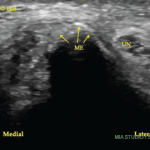Biologics, such as anti-tumor necrosis factor, anti-interleukin (IL) 1, anti-IL-12 and anti-IL-17 agents, can be used in the most refractory cases, Dr. Direskeneli said.1
Oral hygiene is also crucial. Patients with recurrent oral ulcers tend to have impaired dental and periodontal health. One study showed that a mechanical hygiene intervention produced a greater reduction in ulcers in patients at six months than no intervention in control subjects.2
The use of short-term azithromycin to improve oral health can have a beneficial effect, Dr. Direskeneli notes.
Nerve Entrapment
Chris Doughty, MD, clinical director of Neuromuscular Neurology at Brigham and Women’s Hospital, Boston, and assistant professor of neurology at Harvard Medical School, addressed nerve entrapment. He said the key to managing cases of nerve entrapment is to avoid axonal damage by relieving the compression early.
“It’s useful for you, as rheumatologists, to be able to recognize some of these syndromes and act on them quickly,” he said.
The most common nerve entrapment condition is carpal tunnel syndrome. Patients with rheumatoid arthritis and psoriatic arthritis—and to some extent Sjögren’s disease—have carpal tunnel syndrome due to structural changes to the carpal tunnel.
Dr. Doughty noted some diagnosis pitfalls to watch out for in nerve disorders. Often, symptoms are seen in all five fingers, with pain frequently reaching into the forearms. This presentation isn’t helpful to localize the problem because the forearms are outside the territory of the median nerve that is involved in carpal tunnel syndrome. Commonly used maneuvers, such as Tinel (i.e., tapping the carpal tunnel) and Phelan test (i.e., touching the backs of the wrists together), may be more sensitive to tenosynovitis. Therefore, these maneuvers wouldn’t help distinguish carpal tunnel syndrome, he said.
Clinicians can definitively identify involvement of the median nerve if a patient has numbness on the lateral aspect of the fourth digit and normal sensation on the other side of that finger. They can identify that it’s carpal tunnel if there is numbness that spares the area at the base of the thumb. This is virtually diagnostic for carpal tunnel syndrome.
Electromyography and nerve conduction studies can be helpful in localizing the problem, identifying concurrent issues that may also be contributing to symptoms and assessing severity, Dr. Doughty said.
Patient care: Management is guided by the severity of the condition. Patients should begin by avoiding activities that bring on symptoms. Patients can also try occupational therapy and wearing a wrist splint, especially at night when bending may aggravate symptoms, Dr. Doughty said.


